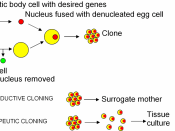Dolly the Sheep was a phenomenon that spread through the world like wildfire. She was born on July 5, 1996 and was the first mammal to be effectively cloned from an adult somatic cell. Dolly was such an amazing discovery because before her creation there was no evidence that distinguished animal cells could form entirely new organisms. It was not easy to create Dolly however, and took 277 tries. Other laboratories at that time were unable to produce a clone or even results similar to DollyÃÂs. Dolly was so influential and renowned because she ''shattered theory in science,ÃÂÃÂ (5) said Dr. Randall Prather, a cloning expert at the University of Missouri. People thought clones were impossible because of the complexity involved, and the failures that had happened in the past. With a great number of skilled biologists and scientists going into the study of cloning, the field has started growing.
Yet, it is a timely and delicate process that has many pros and cons. When a scientist clones an organism, it is as if he is taking life into his own hands and peoples morals and religious views come into play. Yet, cloning can be very beneficial to society, saving the lives of people with incurable dieses that destroy limbs with therapeutic cloning, and making organ transplant waiting lists obsolete.
There are many different types of ways to clone, and many things that can be cloned. The most popular form of cloning and the one the media is often talking of is reproductive cloning. The three main types of cloning are recombinant DNA technology, reproductive cloning, and therapeutic cloning. Recombinant DNA technology is better known as DNA cloning or molecular cloning, and is used to transmit DNA fragments ÃÂfrom a single organism to a self-replicating genetic element as bacterial...


